Rover Group
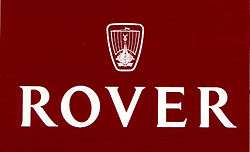 | |
| Industry | Automobiles (Rover, Mini, Land Rover, MG & LDV) |
|---|---|
| Fate | Liquidation & Split |
| Successor |
Land Rover MG Rover Group BMW Mini Tata Group (India) Land Rover SAIC (China) MG Motor |
| Founded |
1986 (Rover Group) 1975 (British Leyland) 1885 (Rover Company) |
| Defunct | 2005 |
| Headquarters | Longbridge, Birmingham, England |
Key people |
Graham Day (CEO, Chairman) Kevin Morley (Director) John Towers (Rover Group Executive) |
| Products | Motor vehicles |
| Parent |
British Government (1986–1987) British Aerospace (1987–1994) BMW (1994–2000) Phoenix Venture Holdings (2000 - 2005) |
| Subsidiaries |
Leyland Vehicles (until 1987) Unipart (until 1987) Austin Rover (until 1989) Land Rover (until 2000) MINI (until 2000) MG (until 2005) Powertrain Ltd (until 2005) MG Rover Group (until 2005) LDV |
The Rover Group plc was the name given in 1986 to the British vehicle manufacturer BL (formerly British Leyland), which had been state-owned company since 1975.[1] It initially included the Austin Rover Group car business (comprising the Austin, Rover, Mini and MG marques), Land Rover Group, Freight Rover vans and Leyland Trucks.
The Rover Group was owned by British Aerospace (BAe) from 1988 to 1994, when BAe sold the remaining car business to the German company BMW. The group was further broken up in 2000, when Ford acquired the Land Rover division, with the Rover and MG marques continuing with the much smaller MG Rover Group until 2005. Ownership of the original Rover Group marques is currently split between BMW (Germany), SAIC (China), and Tata Motors (India).
History
The Rover Group plc was formed by renaming BL plc in 1986, soon after the appointment by Margaret Thatcher of Canadian Graham Day to the position of Chairman and Managing Director of BL.[2]
After divesting of its commercial vehicle and bus manufacturing divisions, and the spares and logistics firm Unipart, the company then consisted of the car manufacturing arm Austin Rover Group and the Land Rover Group. This group was privatised in 1988 by the sale of the company to British Aerospace (BAe) for £150 million,[1][3] who retained Day as joint CEO and Chairman, and made Kevin Morley MD of Rover cars. The group changed its name again in 1989 to Rover Group Holdings Limited.,[4] whilst the car manufacturing subsidiary Austin Rover Group Limited shortened its name to Rover Group Limited.
On 31 January 1994 BAe sold its 80% stake in the company on to German vehicle manufacturer BMW[4][5] for £800 million (a takeover which caused uproar in the House of Commons),[6] the name changing again in 1995 to BMW (UK) Holdings Limited.[4] The Japanese manufacturer Honda, who owned the remaining 20% stake, terminated the long-standing alliance with BL/Rover which had been in existence since 1980 and also sold its shares to BMW a month later, although the licensing agreements surrounding the manufacture of the collaboratively developed Rover 200, 400, 600 and 800 models remained in place.
Millions of pounds of investment by BMW failed to turn the company into profit.[5] It has been estimated that the entire Rover bankruptcy cost BMW fifteen billion Marks.[7] In March 2000, BMW announced its plans to sell the Rover Group. Within two months, much of the group had been sold.
Subsequent developments
Land Rover was spun off from Rover and sold to the Ford Motor Company, becoming part of Ford's Premier Automotive Group, ultimately reuniting it with Jaguar which had been divested from British Leyland in 1984. Following bids from Alchemy Partners and Phoenix Consortium,[8] core areas of manufacturing capability, along with a collection of marques (such as MG), were purchased by the Phoenix Consortium. Much smaller than its predecessors, the newly created manufacturer struggled as it continued the heritage of building cars at the Longbridge plant, which included the original Mini for the final few months of its 41-year production life.
Despite trading as MG Rover Group, the new company's key Rover marque was a property licensed from BMW. The new Mini, which had been developed at Longbridge by Rover Group and was due for launch within a year, along with marques (Riley, Triumph) and former-Rover trademarks (Metro, Maxi) were also strategically retained by BMW. It is believed these names are associated with the heritage of sports saloon car manufacturers, or with the heritage of Mini.
After MG Rover Group's financial crisis and talks of acquisition or investment by Shanghai Automotive Industry Corporation (SAIC) failed in early 2005, the MG Rover Group went into receivership. Following liquidation, SAIC bought the design rights to the acclaimed Rover 75 platform, along with the marques of Austin, Morris, and Wolseley. Nanjing Automobile Corporation bought the rights to the MG marque. In December 2007, Nanjing and SAIC announced their merger, which reunited some of the marques that had formed Rover Group.
Despite BMW agreeing to sell the Rover marque to SAIC,[9] Ford gained control of the luxury saloon name. When Ford's Jaguar and Land-Rover businesses were sold to TATA Motors of India, the rights to the historically prestigious Daimler, Lanchester, and Rover marques transferred to TATA Motors.
Timeline
- 1986: BL plc renamed as The Rover Group plc
- 1986: Rover SD1 production ceases after 10 years and the car is replaced by a new model called the Rover 800 – the result of a joint venture with Honda which led to the manufacture of the Rover 800 and the Honda Legend.
- 1987: The Leyland Trucks division (which by then included Freight Rover Vans) merged with DAF and then floated. (Note: After being declared bankrupt in 1993 the new DAF NV company split into three independent companies; the UK van operation became LDV, the Dutch operation resumed trading as DAF Trucks and the UK truck operation resumed trading as Leyland Trucks. Both truck operations were later acquired by PACCAR of the USA.)
- 1987: Leyland Bus floated off; bought by Volvo Buses in 1988
- 1987: Unipart spare parts division sold off via management buyout
- 1988: Rover Group privatised; sold to British Aerospace
- 1989: The volume car manufacturing subsidiary Austin Rover Group Ltd shortens its name to Rover Group Ltd following the shelving of the Austin brand two years earlier.
- 1989: The new Rover 200 goes on sale, abandoning the four-door saloon bodystyle in favour of a three- and five-door hatchback. It is also sold as the Honda Concerto. Maestro and Montego production is scaled down as a result.
- 1990: The Rover 400 – saloon version of the Rover 200 – goes on sale. Also going into production is the heavily updated Metro, which features modernised body styling, a reworked interior and a new range of engines.
- 1991: The Rover 800 receives a major facelift.
- 1992: Convertible and Coupe versions of the Rover 200 are launched.
- 1993: The Rover 600 is launched, based on the Honda Accord but re-styled and using a mixture of Honda and Rover's own engines.
- 1994: 31 January – British Aerospace announces the sale of its 80% majority share of Rover Group to BMW.[5]
- 1994: 21 February – Honda announces it is selling its 20% share of Rover Group causing major problems in Rover's supply chain which was reliant on Honda.[5]
- 1994: An estate version of the Rover 400 is launched, along with an updated Metro which sees the 14-year-old nameplate shelved and rebadged as the Rover 100. Maestro and Montego production also ends.
- 1995: New versions of the Rover 200 and Rover 400 go on sale, though this time they are entirely different cars. The Rover 400 is a reworked, upmarket version of the latest Honda Civic, despite the Rover-Honda collaboration finishing a year earlier. The new MG F goes on sale, bringing back the MG badge on a mass-production sports car for the first time since 1980.
- 1998: The Rover 75 goes on sale as a successor to both the Rover 600 and Rover 800.
- 1999: The Rover 200 and Rover 400 are facelifted to be re-badged as the Rover 25 and Rover 45 respectively.
- 2000: Land Rover sold by BMW to Ford
- 2000: The new MINI launched by BMW, produced at the Cowley assembly plant.
- 2000: Remainder of company sold to the Phoenix Consortium for a nominal £10 and becomes the MG Rover Group[10]
Models
Rover 800 series
Although the Rover 800 went on sale shortly after BL plc changed its name to Rover Group. It had been developed in conjunction with Honda (whose corresponding model was the Legend). It sold well among buyers in the executive market, with a facelift in 1991, and the introduction of a coupe version a year later. However, it stagnated after a replacement targeted for the 1992 model year was cancelled. Many of its duties as a flagship were performed by the 600. The 800 series was updated again in 1996 which gave the car a chrome and silver grill and a lot more standard kit. By its demise in late 1998, it was looking considerably dated.
Rover 200 series
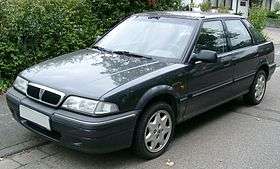

The Rover Group's first significant new car launch was the Rover 200, which was introduced in October 1989. Unlike its predecessor, it was a three- or five-door hatchback instead of a four-door saloon. It used a new range of 16-valve K Series petrol engines as well as a Peugeot 1.9 diesel and 1.8 turbodiesel both fitted to the Phase 1 Peugeot 405. Sales were stronger than its successors, and its launch coincided with a winding-down in production of the similarly sized Maestro, which finally ceased production at the end of 1994 having spent the final years of its life as a budget alternative to the more upmarket Rover 200. Coupe and cabriolet versions of the 200 were later sold, and these were sold alongside the all-new 1995 model and continued until that model was upgraded to become the Rover 25 in 1999. The 1989 Rover 200 was a strong seller throughout its life and its successor continued this trend, though its final year of production (1999) saw a significant dip in sales. These strong sales were not as high as the ever-popular Ford Escort and Vauxhall Astra. The Rover 200 had been around since 1988 as the Longbridge-built Honda Concerto, which offered a higher level of equipment but only achieved a fraction of its sales.
Rover 400 series
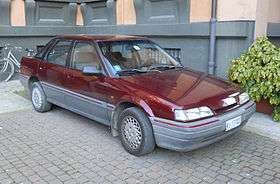
At the beginning of 1990, Rover launched the Rover 400 range. The 400 was essentially a four-door version of the 200 hatchback, but was slightly longer and offered more stowage space. It was sold as an alternative to the likes of the Ford Sierra and Vauxhall Cavalier, but was never able to match the success of these cars. An estate version of the 400 was launched in 1994, and continued alongside the all-new Honda Civic-based model that was launched the following year. The 1995 Rover 400 was a more substantial and popular alternative to other large family cars than its successor was, offering impressive equipment levels, but a relative shortage of interior space because it was nearer in size to cars in the next category down. The Rover 400 was facelifted in 1999 to become the Rover 45, and at the same time the estate version of the original 400 was dropped.
Rover Metro/Rover 100
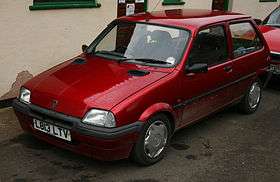

May 1990 saw Rover give the decade-old Metro a major reworking, which most notably included internal and external restyling, as well as new 1.1 and 1.4 K-Series petrol engines. The new Metro offered some of the best standards of specification in any supermini at the time, and it sold well until being replaced by the Rover 100 (essentially another update of the original 1980 design) in late 1994. The Rover 100 remained in production for three years, selling reasonably well, until it was discontinued after a dismal crash test performance that saw demand fall dramatically. Its deletion marked the passing of the last design from the British Leyland era of the company.
Rover 600 series
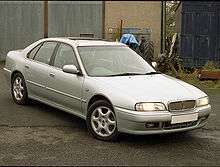
Rover entered the compact executive market in March 1993 with its 600 range. Sold as a four-door saloon, the 600 was based on the Honda Accord but used Rover engines as well as Honda engines (Honda used Rover's diesel engine in their European Accord) and had a classier interior. It was very popular in the compact executive market, but could not match the ever-popular BMW 3 Series. This was down in part to the pricing and model restrictions BMW (Rover group's owner) had placed on the 600 series, and its very close ties with the more down market Honda Accord.
Maestro/Montego

Unlike the Metro, which had received a major re-engineering and was rebadged a Rover, the two last bastions from the old Austin range had become increasingly uncompetitive in the marketplace and were kept in production merely to cater for the budget end of the market and for sale to fleets, as the newer Rover badged models were pushed further upmarket compared to rivals from Ford and General Motors (Vauxhall/Opel). The MG and high specification variants were both dropped from the Maestro/Montego ranges so as not to overlap with the more expensive Rovers. Both had already lost their Austin badging for the 1988 model year and were now known simply by their model names. Although the Montego had received a package of revisions for the 1989 model year, the Maestro remained essentially unchanged until 1992 when it received the Montego's more modern dashboard. Both models were discontinued in 1995, being replaced by the new Honda Civic based Rover 400 series.
Land Rover
The Land Rover arm of the Rover Group expanded dramatically after the late 1980s. The Ninety/One Ten models received minor equipment and driveline upgrades and sales began to improve after a severe and near-terminal decline in the early part of the decade. The Range Rover enjoyed increased sales following its repositioning as a luxury vehicle, with higher equipment levels and options such as an automatic transmission and a diesel engine option being offered for the first time. The successful Discovery 'family' 4x4 was launched in 1989 and became Europe's top-selling 4x4 within 18 months. The Discovery brought with it an advanced diesel engine, which was soon fitted to the other models in the range. This period saw Land Rover rationalise its operations, closing down satellite factories and increasing parts-sharing between models (axles, transmissions and engines were all shared, and the Discovery used the same chassis and many body panels as the Range Rover). The Ninety/One Ten range was fitted with the new diesel engine and renamed the Defender in 1990. An all-new Range Rover was launched in 1994, together with an improved Discovery which maintained high sales. A fourth model, the 'mini-SUV' Freelander was introduced in 1998 and replaced the Discovery as Europe's best-selling 4x4 vehicle.
MG
The MG badge-engineering project (first implemented by Austin Rover in 1982) was ended in 1991 despite some reasonable success for its Maestro and Montego ranges (the MG Metro had been discontinued after the facelift in 1990). The MG badge was revived in 1992 on the RV8 – an updated MGB which made use of a 3.9 V8 Range Rover power unit, but lacked modern refinements that were expected in similarly priced sports car of its era. The car didn't sell as strongly as earlier MG sports car, and production had ended by 1995.
The "real" rebirth of MG sports cars occurred in 1995, when the MG F was launched. Powered by a 1.8 16-valve mid-mounted engine, it was an instant hit with buyers thanks to its distinctive styling and excellent ride and handling. It was a huge success in the roadster renaissance of the late 1990s, despite some buyers being let down by lacklusture build quality and reliability.
Sponsorship
Rover Group sponsored the Scottish football team Dundee United during the early to mid-1990s, including their Scottish Cup triumph in 1994.
References
- 1 2 Hansard: "Rover Group (Privatisation)" debate, 29 Mar 1988
- ↑ Adams, Keith (20 September 2008). "The 1980s: A decade of lost opportunities". AROnline. Retrieved 26 July 2010.
|chapter=ignored (help) - ↑ Adams, Keith (20 September 2008). "Company timeline". AROnline. Retrieved 30 March 2009.
- 1 2 3 Alan Pilkington (1996). Transforming Rover, Renewal against the Odds, 1981–94. Bristol Academic Press, Bristol, pp.199, ISBN 0-9513762-3-3
- 1 2 3 4 "1994: MPs condemn sale of Rover". BBC News. BBC. 1 February 1994. Retrieved 19 March 2008.
- ↑ "1994: MPs condemn sale of Rover". BBC News. 1 February 1994.
- ↑ "Altes vom Auto: Meldungen aus 125 Jahren:Tops und Flops (a summary of the highlights and lowlights of the first 125 years of motoring history)". Auto Motor u. Sport. Heft 4 2011: Seite 16. 27 January 2011.
- ↑ "Financial Times: The Wrong and Winding Road (an analysis of Rover's history)". Financial Times. 12 April 2005.
- ↑ "Financial Times: BMW agrees to sell Rover to SAIC". Financial Times. 12 April 2005.
- ↑ "Rover's Revenge". BBC. 15 May 2000. Retrieved 2007-04-30.
External links
- Why did BMW buy Rover? Retrieved September 2011
| British Leyland – car companies and marques | |||||||||||||||||||||||||||||||||||||||||||||||||||||||||||||
|---|---|---|---|---|---|---|---|---|---|---|---|---|---|---|---|---|---|---|---|---|---|---|---|---|---|---|---|---|---|---|---|---|---|---|---|---|---|---|---|---|---|---|---|---|---|---|---|---|---|---|---|---|---|---|---|---|---|---|---|---|---|
| Marque | 1900s | 1910s | 1920s | 1930s | 1940s | 1950s | 1960s | 1970s | 1980s | 1990s | 2000s | 2010s | |||||||||||||||||||||||||||||||||||||||||||||||||
| Jaguar | SS Cars | Jaguar | Jaguar & Daimler |
BMH | BLMC / British Leyland | Jaguar & Daimler |
Ford (PAG) | Tata | |||||||||||||||||||||||||||||||||||||||||||||||||||||
| Daimler | Daimler | BSA | BSA | ||||||||||||||||||||||||||||||||||||||||||||||||||||||||||
| Lanchester | Lanchester | ||||||||||||||||||||||||||||||||||||||||||||||||||||||||||||
| Rover | Rover Company | Rover Company | Rover Company | Austin Rover Group & Land Rover Group (BL plc) |
Rover Group (BAe) | Rover Group (BMW) |
MG Rover Group (PVH) | ||||||||||||||||||||||||||||||||||||||||||||||||||||||
| Land Rover | Ford (PAG) | ||||||||||||||||||||||||||||||||||||||||||||||||||||||||||||
| Alvis | Alvis | BAE Systems | |||||||||||||||||||||||||||||||||||||||||||||||||||||||||||
| Standard | Standard | Standard Triumph | Leyland Motors | British Motor Heritage | |||||||||||||||||||||||||||||||||||||||||||||||||||||||||
| Triumph | Dawson | Triumph | BMW | ||||||||||||||||||||||||||||||||||||||||||||||||||||||||||
| Riley | Riley | Nuffield Organisation | BMC | BMH | |||||||||||||||||||||||||||||||||||||||||||||||||||||||||
| MG | Morris Garages (MG) | Rover Group (BMW) |
MG Rover Group (PVH) | SAIC & NAC |
SAIC | ||||||||||||||||||||||||||||||||||||||||||||||||||||||||
| Morris | Morris | Morris | |||||||||||||||||||||||||||||||||||||||||||||||||||||||||||
| Wolseley | Wolseley | ||||||||||||||||||||||||||||||||||||||||||||||||||||||||||||
| Austin | Austin | Austin | |||||||||||||||||||||||||||||||||||||||||||||||||||||||||||
| Vanden Plas | Vanden Plas | ||||||||||||||||||||||||||||||||||||||||||||||||||||||||||||
| Mini | BMW | ||||||||||||||||||||||||||||||||||||||||||||||||||||||||||||
| Princess | BMC | BLMC / British Leyland | |||||||||||||||||||||||||||||||||||||||||||||||||||||||||||
| Austin-Healey | Austin (BMC) & Donald Healey | ||||||||||||||||||||||||||||||||||||||||||||||||||||||||||||
| Marque | 1900s | 1910s | 1920s | 1930s | 1940s | 1950s | 1960s | 1970s | 1980s | 1990s | 2000s | 2010s | |||||||||||||||||||||||||||||||||||||||||||||||||
